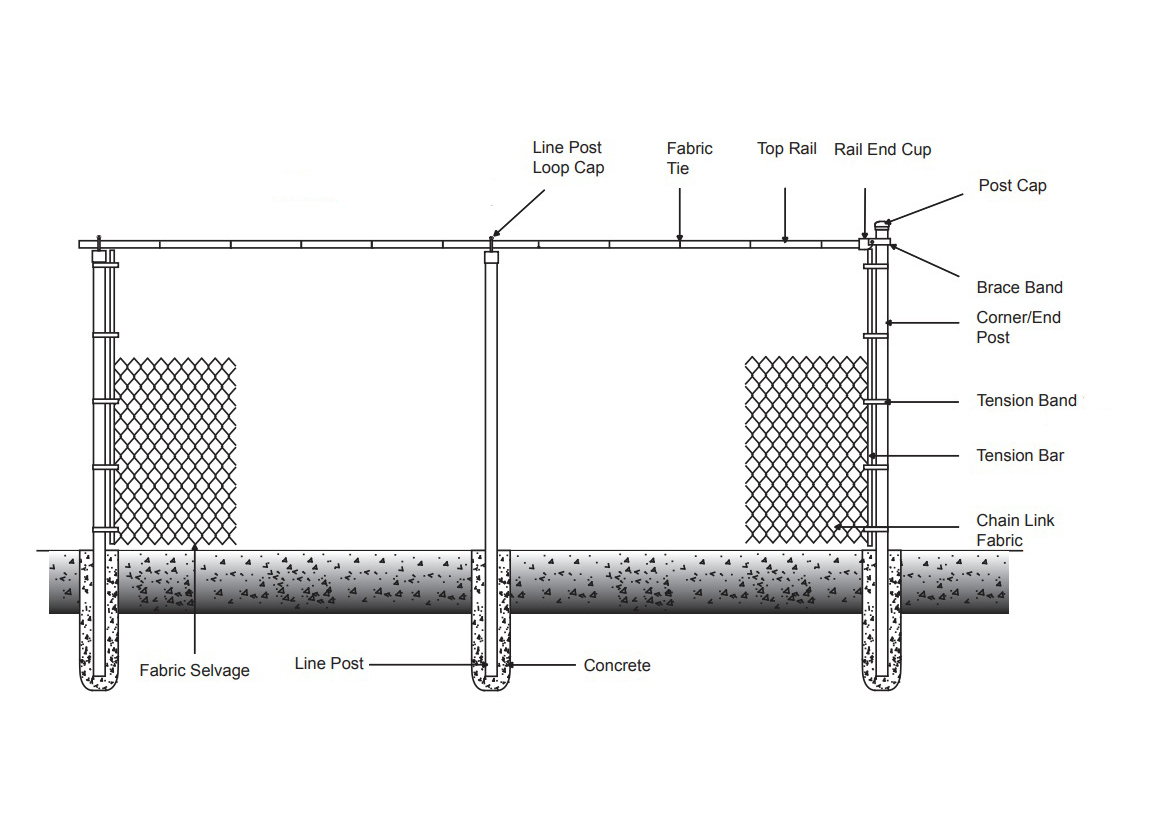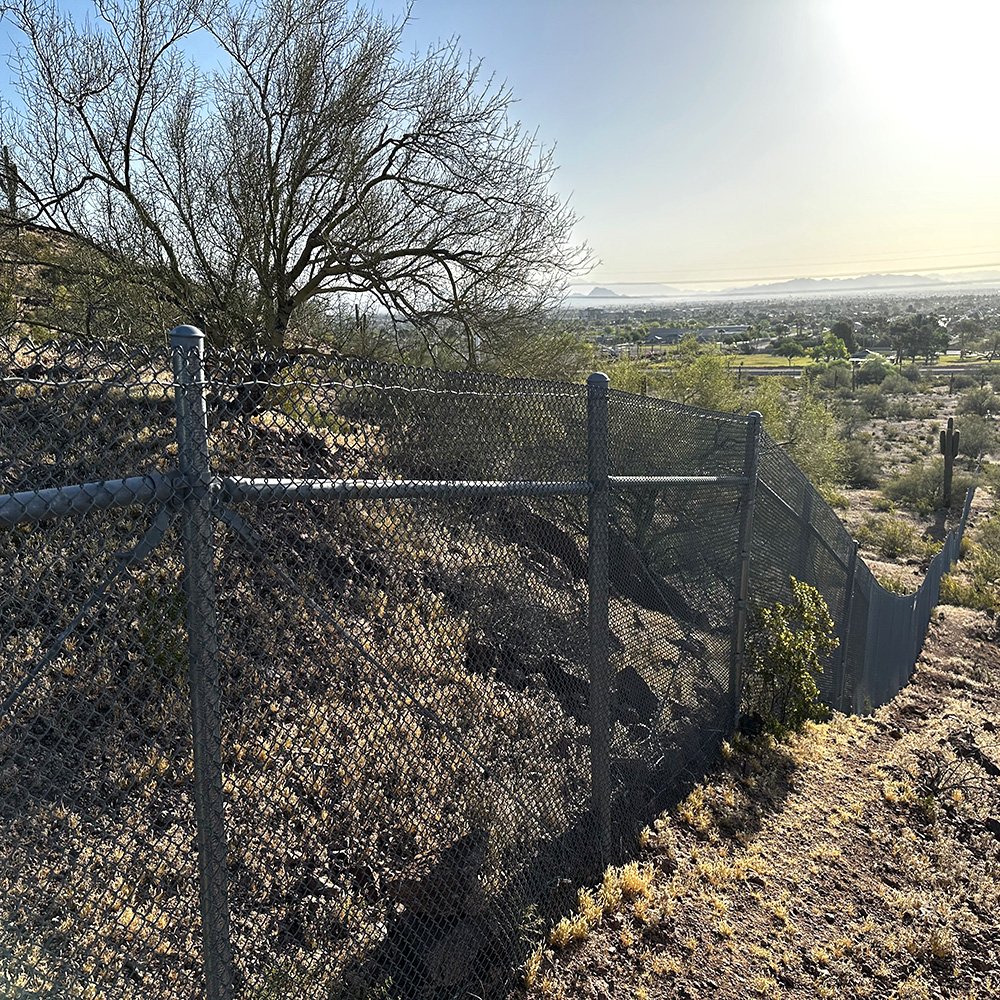Chain Link Fence Installation Diagram
There are endless variations of chain link fencing, as every installation differs by the types of fittings necessary to build a functional fence appropriate for the application. However, the basic structure and parts of chain link fencing remain the same. There are 7 to 8 common parts of a chain link fence, and there are still many variations of the basic structure based on the application needs. Let's review the common parts, and then we will explore a few basic structures with installation diagrams.
Common Chain Link Fence Parts

Common Parts of a Chain Link Fence:
- Tension Bar: A tension bar is a flat, vertical bar woven through the end of the chain link fabric, helping to evenly distribute tension and securely hold the fence fabric against the fence posts.
- Post Cap: A post cap is an accessory used in chain link fencing that fits over the top of fence posts to provide protection and a finished look. These caps prevent water and debris from entering the hollow interior of the posts and enhance the aesthetic appeal of the fence, offering a clean and polished appearance.
- Brace Band: A brace band is used to attach the fence rail or tension wire to the fence post. It is a flat metal band that wraps around the post, providing a secure point of attachment for the rail or wire, helping to distribute the weight evenly across the fence and enhance its stability.
- Tension Band: A tension band secures the chain link fabric to the fence posts, particularly at corners, ends, and gates. It is a flat metal band that encircles the post and is used with a tension bar threaded through the chain link fabric.
- Post: A fence post provides the necessary support and anchorage for the fence fabric and other components. These posts are typically installed regularly along the fence line to maintain the structure's integrity and stability.
- Tension Wire: Tension wire enhances the stability and security of the fence fabric. This wire runs through the fence fabric and is secured to the posts, often using tension bands. Its primary function is to keep the bottom of the fence tight and properly aligned.
- Rail*: A rail in chain link fencing serves as a horizontal support that strengthens the structure and maintains the alignment of the fence. Typically positioned along the top and bottom of the fence, the rail connects to the fence posts through fittings like rail ends and brace bands, helping to distribute the weight and tension of the chain link fabric evenly, providing additional support that prevents sagging and enhances the overall durability of the fence system.
- Chain Link Fabric Chain link fence fabric mesh is made from interwoven steel wires that form a distinctive diamond pattern, this type of fencing is valued for its strength and ability to withstand harsh weather conditions and environmental stress. Easy to install and maintain, chain link fence fabric mesh provides effective security while maintaining visibility, making it an ideal choice for properties that require both protection and the ability to monitor the enclosed area.
*While rails, often referred to as top, bottom, or mid-rails depending on placement, are not depicted here, they can be seen in many other variations of chain link fencing installation diagrams. Often, rails are preferred over tension wire at the top and bottom of each chain link mesh section for more heavy-duty support. While tension wire is strong, some applications call for rails, which provide more stability. However, tension wire can be used in conjunction with rails as well. Tension wire can be used on larger chain link mesh sections to reinforce the fabric between larger sections.
Remember that there is no one-size-fits-all for chain link fence installations. There are many more chain link fence fittings beyond the basics, which Chain Link Fittings offers in many sizes, colors, and variations. So, let's explore some variations of chain link fencing depicted through the following installation diagrams.
Chain Link Fencing Installation Diagrams
Chain Link Installation Diagram: Top Rail Variation

Chain link fencing may only utilize a top rail, as shown in this installation diagram. The choice to only use a top rail would indicate that this chain link fencing is used for maybe a more residential application, allowing for support of the fabric and any additional weight that may be placed on each section when talking to neighbors, hanging decorations, etc. Residential users will save money by not having an unnecessary bottom reinforcement.
Chain Link Installation Diagram: Top and Bottom Rail Variation

This chain link installation diagram depicts the use of a top and bottom rail. This variation of chain link fence structure is common for residential and commercial applications in which more durability is desired. A top and bottom rail reinforcement helps maintain the structural strength and the fabric's alignment.
Chain Link Installation Diagram: Top and Mid Rail with Bottom Tension Wire

Chain link fencing with a top and mid rail and a bottom tension wire is just another variation of chain link fence installation. More commonly used on taller fencing, this style aids mesh alignment and strength. This is a common variation of chain link fencing for recreational facilities, primarily baseball and softball fields or tennis and basketball courts, and depicts the combination of rail and tension wire.
Chain Link Installation Diagram: Top Rail with Braced Tension Wire

Yet another variation of chain link fencing, this installation diagram is similar to the previous diagram, depicting a combination of rail and tension wire use. Also common for recreational facilities, a top and mid rail is used for structural support, while the braced tension wire aids the mesh's strength. This variation also discourages people from climbing the fence.
Please remember that there is no one-size-fits-all for chain link fence installations and endless variations with any combination of fittings. Chain Link Fittings offers fittings, hardware, tools, and educational and instructional information to help you build a fully functional and stable chain link fence. Explore the possibilities by visiting the following pages.
If you have any questions, please get in touch with our friendly sales representatives. They are happy to help in any way they can!
Contact Us



